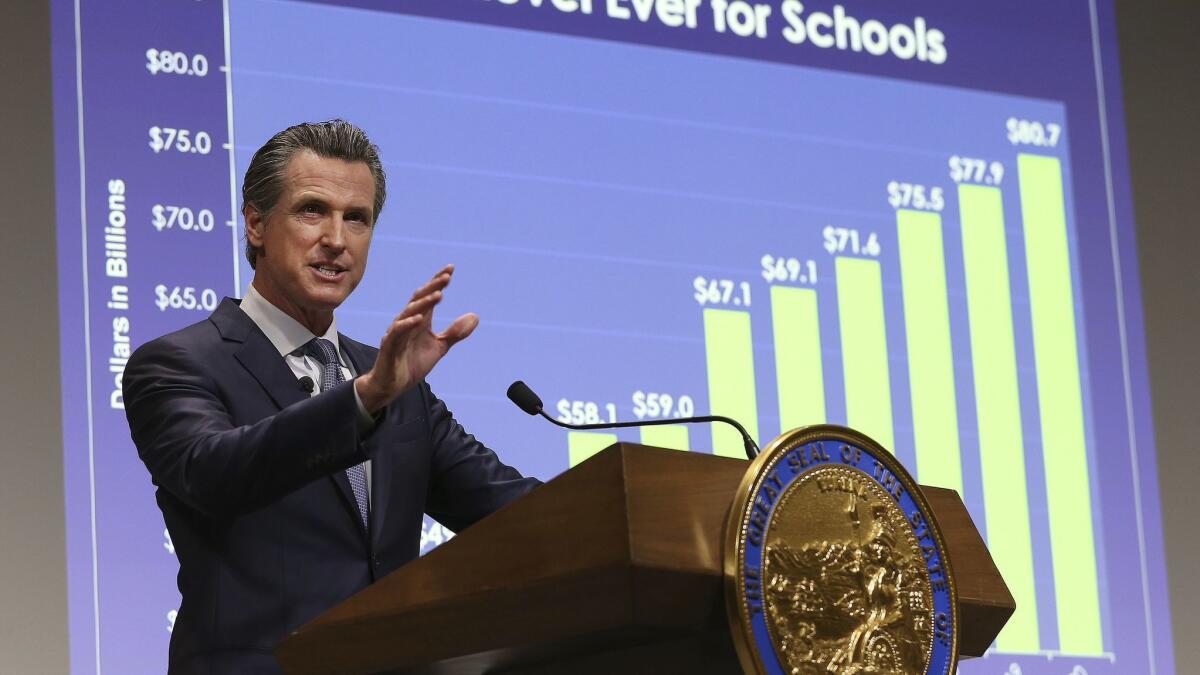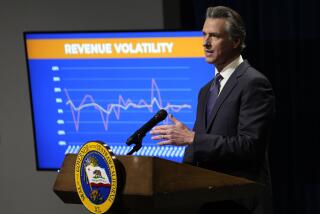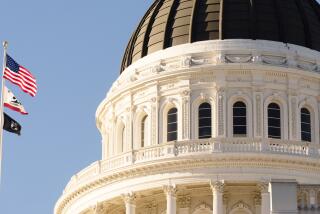News Analysis: California’s $54-billion deficit fueled by coronavirus will test a decade of preparations

- Share via
SACRAMENTO — The warnings had been sounded in Sacramento for years: California was long overdue for an economic downturn, one in which tax revenues would evaporate and leave lawmakers with a series of painful choices in balancing the state budget.
“The next governor’s going to be on the cliff,” then-Gov. Jerry Brown said as he unveiled his final state budget plan in January 2018, pointing to a horizontal line on a chart showing California’s record-breaking economic expansion. “That big red line is what I’ve had. What’s out there is darkness, uncertainty, decline and recession. So good luck, baby!”
But few thought Brown’s doomsday warning would come true so soon. On Thursday, Gov. Gavin Newsom will offer the Legislature his ideas on how to eliminate a deficit that could total $54.3 billion between now and July of next year, fueled by the coronavirus crisis. No economic collapse in modern times has ever happened so fast. Government cash receipts were $1.3 billion above projections through March with only three months left in the fiscal year; now revenues are projected to miss the mark by $9.7 billion through June 30.
“The United States, every state in this nation, will be struggling with unprecedented shortfalls that happened in such a very short period of time,” Newsom said May 7. “And California is no different.”
But California is in a different position — at least in comparison to where it used to be, when the wounds of one crisis were rarely healed by the time the next crisis arrived.
“If there is any silver lining, it is found in the condition of California’s budget, which entered 2020 on strong footing,” wrote Legislative Analyst Gabriel Petek in a report in March. “Throughout the economic expansion, policymakers maintained a focus on enhancing fiscal resilience by adding significantly to the state’s budget reserves.”
The efforts to stockpile cash and pay off short-term debts were championed by lawmakers and Brown over the course of almost a decade and largely embraced by Newsom in the budget he signed last summer. While those assets will do little to protect vital state services if the economy recovers slowly, they could buy the state valuable time if signs of improvement appear later this year or in early 2021.
The state’s main cash reserves — some of which can be easily spent as needs arise, and other money set aside for a “rainy day” kind of emergency — were at near recordlevels when Newsom declared a statewide emergency due to the pandemic in March. With tax collections through this winter still above expectations, the state had $1.3 billion in its short-term reserves to quickly spend on COVID-19 response efforts. Added to that was $1.1 billion in spending for similar needs approved in March by the Legislature.
More than $2 billion in spending would normally cause concern, but the federal government is expected to reimburse the state for a sizable amount of those costs.
Untapped, so far, is California’s “rainy day” fund, the Budget Stabilization Account. Voters created the reserve account in 2004, but it was too small and its deposits too easily suspended by lawmakers to make much of a difference during the Great Recession. Legislators and Brown asked voters to beef up the account in 2014, and it now stands at $16 billion. A separate cash reserve for social services programs, many of which were cut deeply during previous recessions, was created in 2018 and has a balance of about $900 million.
How Newsom and the Legislature choose to use these dollars to help pay the costs of operating schools, prisons, healthcare programs and more will be crucial in the coming weeks. It’s unclear whether the Budget Stabilization Account can be used for expenses both in the current fiscal year and the one beginning on July 1.
But beyond the reserves, the state has a robust amount of operating cash — close to $40 billion of “cash cushion,” according to a report last week by the Legislative Analyst’s Office. Though that money is committed to various government functions, much of it can be used for immediate needs and repaid at a later date.
That kind of flexibility is a key difference from financial meltdowns of the past. In 2009, for example, empty coffers forced state finance officials to issue short-term promissory notes, similar to IOUs, to vendors and taxpayers for the first time since the Great Depression.
Nor was the money quickly replaced in past crises. Services suffered, bond ratings fell and billions of dollars owed to public schools under constitutional mandates were delayed until future years.
It took a years-long push by lawmakers, egged on by Brown, to pay off all of the various cash management schemes that had created what he called a $35-billion “wall of debt.” Newsom’s first budget made the final $4.5-billion payment to erase the problems of that era.
The historic run of good economic times allowed other stains too to be washed off California’s budget ledger. In 2004, voters approved the sale of $15 billion in deficit bonds, a solution no longer allowed under state law. The final payment was made in 2015 — earlier payments averaged $1 million a day, every day for 11 years.
It was hardly the era’s only brazen budget gimmick. In 2009, lawmakers not only changed the dates for Californians who pay quarterly estimated taxes — still on the books a decade later — but shifted the payday for state workers by a single day so it would be counted in the following fiscal year’s expenses. Newsom also undid that maneuver last year.
What happens this time around depends on whether lawmakers see the tough choices as the solution to a problem or a means to an end. In other words, whether they seek to use the various tools at their disposal — cash reserves, short-term internal borrowing — as a temporary fix to pave the way for a faster recovery.
One early idea was floated last week by Assemblyman Phil Ting (D-San Francisco), who suggested lawmakers use state tax dollars to help the unemployed when their jobless benefits run out.
“That additional assistance will help us in the long term,” he said, by keeping struggling Californians from using more expensive safety net programs for years to come.
Newsom and lawmakers may not be able to avoid all of the tough choices. But compared to the gloomy landscape their predecessors saw in the wake of economic collapses, there are bright spots this time that could, at the very least, buy them some time.
More to Read
Sign up for Essential California
The most important California stories and recommendations in your inbox every morning.
You may occasionally receive promotional content from the Los Angeles Times.











